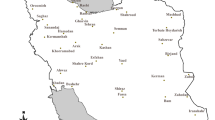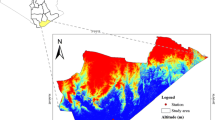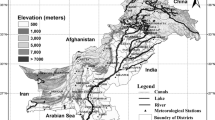Abstract
Determining drought indices and characteristics in Algeria is crucial because droughts significantly impact water resources and agricultural production. Additionally, identifying the most suitable drought indicator for the region facilitates effective monitoring of droughts. The study’s main objective is to compare hydro-meteorological droughts, determine their distribution, and assess drought risk. Various drought indices, which are continuous functions of rainfall and other hydro-meteorological variables, are typically used for this purpose. This study calculates seven indices' effectiveness for drought monitoring and assessment in Algeria's Wadi Ouhrane basin. For this purpose, the temporal variation of drought indicators, distribution graphs, weighted Cohen's kappa (Kw), and correlation coefficient values was compared. Among the indices used in the study, four indices, namely SPI, CZI, ZSI, and MCZI, showed high similarity in their behavior. As the time scale increases from 1 to 24 months, the correlation coefficient exceeds 0.97, and Kw becomes greater than 0.57. Furthermore, there is a weak correlation (R < 0.4) between the meteorological and hydrological-based SRI indicators, and the highest correlation was found between the RDI and SRI indices. Therefore, these indices indicate that the precipitation and ET (temperature) ratio is more suitable for hydrological drought studies.









Similar content being viewed by others
Data availability
Data will be made available upon reasonable request.
References
Azhdari Z, Bazrafshan J (2022) A hybrid drought Index for assessing agricultural drought in arid and semi-arid coastal areas of Southern Iran. Int J Environ Sci Technol 19(10):9409–9426. https://doi.org/10.1007/s13762-022-04154-3
Abramowitz M, Stegun, IA (eds) 1964 Handbook of mathematical functions with formulas, graphs, and mathematical tables, vol 55. US Government Printing Office
Achite M, Bazrafshan O, Wałęga A, Azhdari Z, Krakauer N, Caloiero T (2022) Meteorological and hydrological drought risk assessment using multi-dimensional copulas in the Wadi Ouahrane Basin in Algeria. Water 14(4):653. https://doi.org/10.3390/w14040653
Achite M, Simsek O, Adarsh S, Hartani T, Caloiero T (2023) Assessment and monitoring of meteorological and hydrological drought in semiarid regions: The Wadi Ouahrane basin case study (Algeria). Phys Chem Earth Parts a/b/c 130:103386. https://doi.org/10.1016/j.pce.2023.103386
Adnan S, Ullah K, Shuanglin L, Gao S, Khan AH, Mahmood R (2018) Comparison of various drought indices to monitor drought status in Pakistan. Clim Dyn 51(5–6):1885–1899. https://doi.org/10.1007/s00382-017-3987-0
Asadi Zarch MA, Malekinezhad H, Mobin MH, Dastorani MT, Kousari MR (2011) Drought monitoring by reconnaissance drought index (RDI) in Iran. Water Resour Manage 25(13):3485–3504. https://doi.org/10.1007/s11269-011-9867-1
Azhdari Z, Bazrafshan O, Shekari M, Zamani H (2020) Three-dimensional risk analysis of hydro-meteorological drought using multivariate nonlinear index. Theoret Appl Climatol 142(3):1311–1327. https://doi.org/10.1007/s00704-020-03365-3
Ballah A, Benaabidate L (2021) Assessing the performance of various meteorological drought indices in capturing historic droughts in the south of Algeria. Arab J Geosci 14:1289. https://doi.org/10.1007/s12517-021-07556-8
Bazrafshan O, Salajegheh A, Bazrafshan J, Mahdavi M, Fatehi Maraj A (2015) Hydrological drought forecasting using ARIMA models (case study: Karkheh Basin). Ecopersia 3(3):1099–1117
Bazrafshan O, Mahmudzadeh F, Bazrafshan J (2017) Evaluation of temporal trends of the drought indices SPI and SPEI in the Southern Coast of Iran. Desert Manag 4(8):54–69. https://doi.org/10.22034/jdmal.2017.24662
Bazrafshan O, Zamani H, Shekari M, Singh VP (2020) Regional risk analysis and derivation of copula-based drought for severity-duration curve in arid and semi-arid regions. Theoret Appl Climatol 141(3):889–905. https://doi.org/10.1007/s00704-020-03217-0
Berhail S, Katipoğlu OM (2023) Spatiotemporal detection of abrupt change in trends of rainfall and dry and wet periods at different time scales: The case of the Medjerda basin in northeast Algeria. Acta Geophys. https://doi.org/10.1007/s11600-023-01097-2
Bettahar A, Şener Ş (2022) Analysis of meteorological drought indices in the Wadi Righ area (southern Algeria). Sustain Water Resour Manag 8:152. https://doi.org/10.1007/s40899-022-00740-y
Bougara H, Baba Hamed K, Borgemeister C, Tischbein B, Kumar N (2021) A comparative assessment of meteorological drought in the Tafna basin, Northwestern Algeria. J Water Land Dev 51(1):78–93. https://doi.org/10.24425/jwld.2021.139018
Chowdhury MAI, Kabir MM, Sayed AF, Hossain S (2016) Estimation of rainfall patterns in Bangladesh using different computational methods (arithmetic average, thiessen polygon and isohyet). J Biodivers Environ Sci 8(1):43–51
Cohen J (1960) A coefficient of agreement for nominal scales. Educ Psychol Measur 20(1):37–46. https://doi.org/10.1177/00131644600200010
Edwards DC, McKee TB (1997) Characteristics of 20th century drought in the United States at multiple time scales. Climatology report 97–2. Department of Atmospheric Science, Colorado State University, Fort Collins, Colorado
Eghtedar Nezhad M, Bazrafshan O, Sadeghi Lari A (2017) Adaptive evaluation of SPI, RDI and SDI indices in analyzing the meteorological and hydrological drought characteristics (Case study: Bam Plain). Water Soil Sci 26(4.2):69–81
Hernandez EA, Venkatesh Uddameri V (2014) Standardized precipitation evaporation index (SPEI)-based drought assessment in semi-arid south Texas. Environ Earth Sci 71:2491–2501. https://doi.org/10.1007/s12665-013-2897-7
Jain VK, Pandey RP, Jain MK, Byun HR (2015) Comparison of drought indices for appraisal of drought characteristics in the Ken River Basin. Weather Climate Extremes 8:1–11. https://doi.org/10.1016/j.wace.2015.05.002
Jamshidi H, Khalili D, Zadeh MR, Hosseinipour EZ (2011) Assessment and comparison of SPI and RDI meteorological drought indices in selected synoptic stations of Iran. In: Proceedings of the world environmental and water resources congress 2011: bearing knowledge for sustainability. 22–26 May 2011, Palm Springs, California, pp 1161–1173
Kapluhan E (2013) Drought and drought in Turkey effect of agriculture. Marmara Geogr Rev 27:487–510
Katipoğlu OM (2023) Prediction of streamflow drought index for short-term hydrological drought in the semi-arid Yesilirmak Basin using Wavelet transform and artificial intelligence techniques. Sustainability 15(2):1109. https://doi.org/10.3390/su15021109
Katipoğlu OM, Acar R, Şengül S (2020) Comparison of meteorological indices for drought monitoring and evaluating: a case study from Euphrates basin, Turkey. J Water Climate Change 11(S1):29–43
Katipoğlu OM, Can I (2018) Estimation of drought risks using Archimedean copulas in the Karasu River, Turkey. Feb Fresenius Environ Bull 25:9799
Kendall M, Stuart A (1977) The advanced theory of statistics. Distribution theory, vol 1. Griffin, London
Landis JR, Koch GG (1977) The measurement of observer agreement for categorical data. J Biom 33:159–174. https://doi.org/10.2307/2529310
Li J, Zhou S, Hu R (2016) Hydrological drought class transition using SPI and SRI time series by loglinear regression. Water Resour Manage 30(2):669–684. https://doi.org/10.1007/s11269-015-1184-7
Lweendo MK, Lu B, Wang M, Zhang H, Xu W (2017) Characterization of droughts in humid subtropical region, upper Kafue river basin (southern Africa). Water 9(4):242. https://doi.org/10.3390/w9040242
Mahmoudi P, Rigi A, Miri Kamak M (2019) A comparative study of precipitation-based drought indices with the aim of selecting the best index for drought monitoring in Iran. Theoret Appl Climatol 137:3123–3138
McKee TB, Doesken NJ and Kleist J (1993) The relationship of drought frequency and duration to time scales. In: 8th conference on applied climatology, Anaheim, 17–22 January 1993, 179–184
McKee TB (1995) Drought monitoring with multiple time scales. In: Proceedings of 9th conference on applied climatology, Boston
Morid S, Smakhtin V, Moghaddasi M (2006) Comparison of seven meteorological indices for drought monitoring in Iran. Int J Climatol J R Meteorol Soc 26(7):971–985. https://doi.org/10.1002/joc.1264
Naylor LW, Eadie JM, Smith WD, Eichholz M, Gray MJ (2005) A simple method to predict seed yield in moist-soil habitats. Wildl Soc Bull 33(4):1335–1341
Pashiardis S, Michaelides S (2008) Implementation of the standardized precipitation index (SPI) and the reconnaissance drought index (RDI) for regional drought assessment: a case study for Cyprus. European Water 23(24):57–65
Payab AH, Türker U (2019) Comparison of standardized meteorological indices for drought monitoring at northern part of Cyprus. Environ Earth Sci 78(10):309. https://doi.org/10.1007/s12665-019-8309-x
Salimi H, Asadi E, Darbandi S (2021) Meteorological and hydrological drought monitoring using several drought indices. Appl Water Sci 11:11. https://doi.org/10.1007/s13201-020-01345-6
Sivakumar MV, Motha R, Wilhite D, Wood D (2011) Agricultural drought indices. In: proceedings of an expert meeting, 2–4 June, 2010. WMO, Murcia, Spain
Smakhtin VU, Hughes DA (2007) Automated estimation and analyses of meteorological drought characteristics from monthly rainfall data. Environ Model Softw 22(6):880–890. https://doi.org/10.1016/j.envsoft.2006.05.013
Thornthwaite CW (1948) An approach toward a rational classification of climate. Geogr Rev 38(1):55–94. https://doi.org/10.2307/210739
Tigkas D, Vangelis H, Tsakiris G (2015) DrinC: a software for drought analysis based on drought indices. Earth Sci Inf 8(3):697e709. https://doi.org/10.1007/s12145-014-0178-y
Tirivarombo S, Osupile D, Eliasson P (2018) Drought monitoring and analysis: standardised precipitation evapotranspiration index (SPEI) and standardised precipitation index (SPI). Phys Chem Earth Parts a/b/c 106:1–10. https://doi.org/10.1016/j.pce.2018.07.001
Tsakiris G, Vangelis HJEW (2005) Establishing a drought index incorporating evapotranspiration. European Water 9(10):3–11
Umran Komuscu A (1999) Using the SPI to analyze spatial and temporal patterns of drought in Turkey. Drought Netw News 1994–2001:49
Vergni L, Todisco F, Di Lena B (2021) Evaluation of the similarity between drought indices by correlation analysis and Cohen’s Kappa test in a Mediterranean area. Nat Hazards 108(2):2187–2209. https://doi.org/10.1007/s11069-021-04775-w
Vicente-Serrano SM, Beguería S, López-Moreno JI, Angulo M, and El Kenawy A (2010) A new global 0.5 gridded dataset (1901–2006) of a multiscalar drought index: comparison with current drought index datasets based on the Palmer Drought Severity Index. J Hydrometeorol 11(4):1033–1043. https://doi.org/10.1175/2010JHM1224.1
Vicente-Serrano SM, Beguería S, Lorenzo-Lacruz J, Camarero JJ, López-Moreno JI, Azorin-Molina C, Revuelto J, Morán-Tejeda E, Sanchez-Lorenzo A (2012) Performance of drought indices for ecological, agricultural, and hydrological applications. Earth Interact 16(10):1–27. https://doi.org/10.1175/2012EI000434.1
Wable PS, Jha MK, Shekhar A (2019) Comparison of drought indices in a semi-arid river basin of India. Water Resour Manage 33(1):75–102. https://doi.org/10.1007/s11269-018-2089-z
Wang H, Pan Y, Chen Y (2017) Comparison of three drought indices and their evolutionary characteristics in the arid region of northwestern China. Atmos Sci Lett 18(3):132–139. https://doi.org/10.1002/asl.735
Wilhite DA (2005) Drought and water crises: science, technology, and management issues. CRC Press, Boca Raton
Wilhite D, Pulwarty RS (2017) Drought and Water Crises: Integrating Science, Management, and Policy. CRC Press, Boca Raton, FL, USA
Wu H, Hayes MJ, Weiss A, Hu QI (2001) An evaluation of the standardized precipitation index, the China-Z Index and the statistical Z-score. Int J Climatol J R Meteorol Soc 21(6):745–758. https://doi.org/10.1002/joc.658
Yevjevich VM (1967) An objective approach to definitions and investigations of continental hydrologic droughts. Hydrologic Paper 23, Colorado State University, Fort Collins, USA
Yue Y, Shen SH, Wang Q (2018) Trend and variability in droughts in Northeast China based on the reconnaissance drought index. Water 10(3):318. https://doi.org/10.3390/w10030318
Acknowledgements
We thank the ANRH agency for the collected data and the General Directorate of Scientific Research and Technological Development of Algeria (DGRSDT).
Funding
No funding was received for conducting this study.
Author information
Authors and Affiliations
Contributions
MA contributed with data collection, literature review, and writing study area. OB and ZA contributed to the data analysis and writing the methods and findings. OMK contributed to the writing the findings and conclusions and review of the article. All authors read and approved the final manuscript.
Corresponding author
Ethics declarations
Conflicts of interest
The author declares no conflict of interest.
Ethical Approval
The manuscript complies with all the ethical requirements. The paper was not published in any journal.
Consent to participate
Not applicable.
Consent for publication
Not applicable.
Additional information
Publisher's Note
Springer Nature remains neutral with regard to jurisdictional claims in published maps and institutional affiliations.
Rights and permissions
Springer Nature or its licensor (e.g. a society or other partner) holds exclusive rights to this article under a publishing agreement with the author(s) or other rightsholder(s); author self-archiving of the accepted manuscript version of this article is solely governed by the terms of such publishing agreement and applicable law.
About this article
Cite this article
Achite, M., Bazrafshan, O., Katipoğlu, O.M. et al. Evaluation of hydro-meteorological drought indices for characterizing historical droughts in the Mediterranean climate of Algeria. Nat Hazards 118, 427–453 (2023). https://doi.org/10.1007/s11069-023-06012-y
Received:
Accepted:
Published:
Issue Date:
DOI: https://doi.org/10.1007/s11069-023-06012-y




